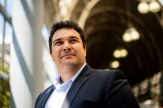Opera singers: The 19th century’s Hollywood stars
In her new book “Changing the Score: Arias, Prima Donnas, and the Authority of Performance” (Oxford University Press, the AMS Series in Music), Northeastern University assistant music professor Hilary Poriss reveals some of the backstage drama in Italian operatic history that set the tone for some of the world’s most famous scores.
In their heyday, 19th-century Italian opera performers were the ‘Angelina Jolies’ and ‘Brad Pitts’ of their time, according to Poriss. Their celebrity status gave them the power to make or break the careers of some of the most famous composers of the time—legends like Rossini, and Donizetti—and these operatic stars flaunted their status by making changes to operas as they saw fit.
“Singers had a lot of power in the 19th century. They were the ones audiences came to see,” Poriss says. “Opera was the main form of entertainment in Italy at the time, and so singers were paid more than composers—a tradition that goes back to the 17th century. Theater managers and composers knew that the audience came to hear their favorite singer, and not the new opera.” Just like today’s audiences are drawn to see their favorite movie stars on-screen.
Hollywood celebrities, however, rarely get the artistic license granted to opera singers of that time, who routinely overlooked composers’ scores and inserted their own favorite arias into the performances.
In the famed “lesson scene” in Rossini’s “The Barber of Seville,” for example, the composer’s work was rarely performed. Instead, a performer would introduce another aria, often by another composer, that they felt fit the overall opera, explains Poriss. “This is something that would never happen today. But at the time, from about 1825 to 1850, we really saw a growth in Prima Donnas, and composers were utterly reliant on them.”
A violinist since she was four, Poriss was drawn to music history and the opera during her undergraduate years at Bates College, where she “discovered the whole world of music history.” She also found that she felt more comfortable in a classroom setting teaching than she ever had on stage playing the violin.
After earning her undergraduate degree, she studied with the renowned music professor Philip Gossett at the University of Chicago, earning her master’s and later her doctorate in music history. Prior to coming to Northeastern in 2006, she won the prestigious Rome Prize from the American Academy in Rome to travel to Italy and complete her book.
Her work is lauded by Susan Rutherford, author of “The Prima Donna and Opera, 1815-1930,” for its “lively prose and fresh perspectives of a little explored area of operatic performance practice.” Poriss’s first book, which is part of the American Musicological Society Series on Music, also garnered praise from Mark Everist, also an author of two books on music history, and who said of her work: “Hilary Poriss invites us into a world where so many musical certainties seem to vanish.”




